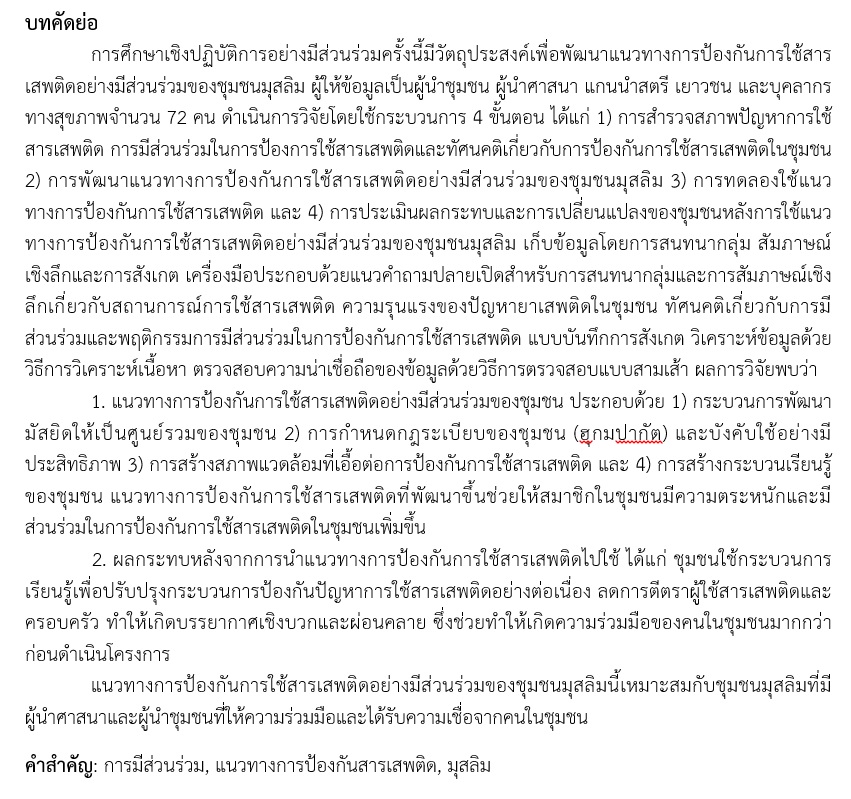แนวทางการป้องกันการใช้สารเสพติดอย่างมีส่วนร่วมของชุมชนมุสลิม
คำสำคัญ:
การมีส่วนร่วม, แนวทางการป้องกันสารเสพติด, มุสลิมบทคัดย่อ
การศึกษาเชิงปฏิบัติการอย่างมีส่วนร่วมครั้งนี้มีวัตถุประสงค์เพื่อพัฒนาแนวทางการป้องกันการใช้สารเสพติดอย่างมีส่วนร่วมของชุมชนมุสลิม ผู้ให้ข้อมูลเป็นผู้นำชุมชน ผู้นำศาสนา แกนนำสตรี เยาวชน และบุคลากรทางสุขภาพจำนวน 72 คน ดำเนินการวิจัยโดยใช้กระบวนการ 4 ขั้นตอน ได้แก่ 1) การสำรวจสภาพปัญหาการใช้สารเสพติด การมีส่วนร่วมในการป้องการใช้สารเสพติดและทัศนคติเกี่ยวกับการป้องกันการใช้สารเสพติดในชุมชน 2) การพัฒนาแนวทางการป้องกันการใช้สารเสพติดอย่างมีส่วนร่วมของชุมชนมุสลิม 3) การทดลองใช้แนวทางการป้องกันการใช้สารเสพติด และ 4) การประเมินผลกระทบและการเปลี่ยนแปลงของชุมชนหลังการใช้แนวทางการป้องกันการใช้สารเสพติดอย่างมีส่วนร่วมของชุมชนมุสลิม เก็บข้อมูลโดยการสนทนากลุ่ม สัมภาษณ์เชิงลึกและการสังเกต เครื่องมือประกอบด้วยแนวคำถามปลายเปิดสำหรับการสนทนากลุ่มและการสัมภาษณ์เชิงลึกเกี่ยวกับสถานการณ์การใช้สารเสพติด ความรุนแรงของปัญหายาเสพติดในชุมชน ทัศนคติเกี่ยวกับการมี ส่วนร่วมและพฤติกรรมการมีส่วนร่วมในการป้องกันการใช้สารเสพติด แบบบันทึกการสังเกต วิเคราะห์ข้อมูลด้วยวิธีการวิเคราะห์เนื้อหา ตรวจสอบความน่าเชื่อถือของข้อมูลด้วยวิธีการตรวจสอบแบบสามเส้า ผลการวิจัยพบว่า
1. แนวทางการป้องกันการใช้สารเสพติดอย่างมีส่วนร่วมของชุมชน ประกอบด้วย 1) กระบวนการพัฒนามัสยิดให้เป็นศูนย์รวมของชุมชน 2) การกำหนดกฎระเบียบของชุมชน (ฮุกมปากัต) และบังคับใช้อย่างมีประสิทธิภาพ 3) การสร้างสภาพแวดล้อมที่เอื้อต่อการป้องกันการใช้สารเสพติด และ 4) การสร้างกระบวนเรียนรู้ของชุมชน แนวทางการป้องกันการใช้สารเสพติดที่พัฒนาขึ้นช่วยให้สมาชิกในชุมชนมีความตระหนักและมี ส่วนร่วมในการป้องกันการใช้สารเสพติดในชุมชนเพิ่มขึ้น
2. ผลกระทบหลังจากการนำแนวทางการป้องกันการใช้สารเสพติดไปใช้ ได้แก่ ชุมชนใช้กระบวนการเรียนรู้เพื่อปรับปรุงกระบวนการป้องกันปัญหาการใช้สารเสพติดอย่างต่อเนื่อง ลดการตีตราผู้ใช้สารเสพติดและครอบครัว ทำให้เกิดบรรยากาศเชิงบวกและผ่อนคลาย ซึ่งช่วยทำให้เกิดความร่วมมือของคนในชุมชนมากกว่าก่อนดำเนินโครงการ
แนวทางการป้องกันการใช้สารเสพติดอย่างมีส่วนร่วมของชุมชนมุสลิมนี้เหมาะสมกับชุมชนมุสลิมที่มีผู้นำศาสนาและผู้นำชุมชนที่ให้ความร่วมมือและได้รับความเชื่อจากคนในชุมชน
เอกสารอ้างอิง
Angkurawaranon, C., Jiraporncharoen, W., Likhitsathian, S., Thaikla, K., Kanato, M., Perngparn, U., Assanangkornchai, S., et al. (2018). Trends in the Use of Illicit Substances in Thailand: Results from National Household Surveys. Drug and Alcohol Review, 37(5), 658–663.
Assanangkornchai, S., Nima, P., McNeil, E. B., & Edwards, J. G. (2015). Comparative Trial of the WHO ASSIST- Linked Brief Intervention and Simple Advice for Substance Abuse in Primary Care. Asian Journal of Psychiatry, 18(1), 75-80. doi 10.1016/j.ajp.2015.09.003.
Assanangkornchai, S., Pattanasattayawong, U., Samangsri, N., & Mukthong, A. (2007). Substance Used Among High School Students in Southern Thailand: Trends Over 3 Years (2002-2004). Drug and Alcohol Dependence, 86(1), 167-174.
Binlateh, W., & Thongchuay, C. (2010). The Process of Sustaining Muslim Identities and Strong Community Building: The Case Study of Ban Nua Mosque Community. AL-NUR Journal, 5(9), 55-66. (in Thai)
Choosunthia, W., & Pinitsuntorn, S. (2017). The Impact of Drug Addition on Patients Admitted to Thanyarakhospital, Udonthani: A Case Study. Community Health Development Quarterly Khon Kaen University, 5(3), 523-533. (in Thai)
Crapanzano, K. A., Hammarlund, R., Ahmad, B., Hunsinger, N., & Kullar, R. (2019). The Association Between Perceived Stigma and Substance Use Disorder Treatment Outcomes: A Review. Substance Abuse and Rehabilitation, 10(1), 1-12.
Humeniuk, R., Ali, R., Babor, T., Souza-Formigoni, M. L. O., Lacerda, R. B. D., Ling, W., et al. (2012). A Randomized Controlled Trial of a Brief Intervention for Illicit Drugs Linked to the Alcohol, Smoking and Substance Involvement Screening Test (ASSIST) in Clients Recruited from Primary Health-Care Settings in Four Countries. Addiction, 107(5), 957–966.
Intajan, T., Kohtbantau, S. & La-Ongthong, S. (2013). A Model of Narcotics Prevention in Vocational Institutions in the Lower Northeast. Rajabhat Maha Sarakham University Journal, 7(1), 63-71. (in Thai)
Intaprom, W. (2019). Analysis and Presentation of Qualitative Data Analysis. Academic Journal Phranakhon Rajabhat University, 10(2), 313-333. (in Thai)
Jeharsae, R., Tohpa, H., Jehwae, C., Jehsoh, J., Nupech, C., Waeteh, S., et al. (2018). Development of A Mosque-Center Model of Prevention of Illegal Substance Use: A Case Study of Muslim Village in Pattani Province. Princess Naradhiwas University J, 10(1), 67-78. (in Thai)
Jeharsae, R., Tohpa, H., Waeteh, S., Nupech, C., Jeasoh, J., Binlatieh, W., et al. (2017). Prevalence of Illegal Substance Use, Participation in Drug Prevention of Illegal Substance Use Program Among Muslims in the Southernmost Provinces. ASJ PSU, 28(2), 195-207. (in Thai)
Kanong, P. (2014). Participatory Development of the People in Protection for Drug Problems Model: A Case Study Honghee Vinllage, Yangtarad Sub-District, Yangtarad District, Kalasin Province. Mahasarakham University: Mahasarakham.
Kohkawee, S. (2017). Integration among Homes, Schools, and Mosques to Prevent the Drug Problems Among Young Muslims in Phuket Province. Phuket Rajabhat University AcademicJourna, 13(1), 216–238. (in Thai)
Miller, B. A., Holder, H. D., & Voas, R. B. (2009). Environmental Strategies for Prevention of Drug Use and Risks in Clubs. J Subst Use, 14(1), 19-38. doi:10.1080/14659890802305887.
Muninaem, K. (2019). Drug Problem Solving by Community Leaders and People in Barahor Mueang District, Pattani Province. Prince of Songkla University. Songkhla.
Ocharot, T., Sathitanant, S. & Singhalert, R. (2011). A Model of the Protection and Solution for Drug Problems by Participatory Action Research: A Case Study of Khambong Sub-District Municipality, Huaypheung District, Kalasin Province. Rajabhat Maha Sarakham University Journal, 5(2), 73-85. (in Thai)
Pereira, A. P., Paes, A. T., & Sanchez, Z. M. (2016). Factors Associated with The Implementation of Programs for Drug Abuse Prevention in Schools. Rev Saude Publica, 50(44), 1-10. doi:10.1590/S1518-8787.2016050005819.
Rashid, R. A., Kamali, K., Habil, M, H., Shaharom, M, H., Seghatoleslam, T., & Looyeh, M, Y. (2014). A Mosque-Based Methadone Maintenance Treatment Strategy: Implementation and Pilot Results. International Journal of Drug Policy, 25(1), 1071-1075. doi: 10.1016/j.drugpo.2014.07.003.
Songkhla Provincial Office. (2009). Songkhla Province Information. Retrieved November 28, 2018 from https://www.songkhla.go.th/files/com_news_operation/2015-01/20150107_xkbxnxru.pdf.
Suksang, S., Kahkomwong, R., Ngamingyaod, W., & Chotchuong, A. (2017). Surveillance Model in Preventing and Solving Drug Abuse Problem by Public Sector: A Case Study in Tha Pae District, Satun Province, and Rataphum District, Songkhla Province. The Southern College Network Journal of Nursing and Public Health, 4,(special),s230-s242. (in Thai)
Suphromin, S. (2020). The Effect of Motivation Enhancement Program on Behavior Change in Drugaddicts Group of Community Nursesin MueangRoiEt District Roi Et Province, Preceding of the 7th NEU National Conference 2020 (pp. 596–605): North Eastern University.
Talek, M. F., Cottler, L. B., & Assanangkornchai, S. (2017). Estimating the Size of the Drug Using Population in Three Deep-South Provinces of Thailand: Results from A Service Multiplier and Respondent Driven Sampling (RDS) Method. ASEAN Journal of Psychiatry, 18(2), 174-184.

ดาวน์โหลด
เผยแพร่แล้ว
ฉบับ
ประเภทบทความ
สัญญาอนุญาต
1. บทความหรือข้อคิดเห็นใด ๆ ที่ปรากฏในวารสารเครือข่าย วิทยาลัยพยาบาลและการสาธารณสุขภาคใต้ ที่เป็นวรรณกรรมของผู้เขียน บรรณาธิการหรือเครือข่ายวิทยาลัยพยาบาลและวิทยาลัยการสาธารณสุขภาคใต้ ไม่จำเป็นต้องเห็นด้วย
2. บทความที่ได้รับการตีพิมพ์ถือเป็นลิขสิทธิ์ของ วารสารเครือข่ายวิทยาลัยพยาบาลและการสาธารณสุขภาคใต้







